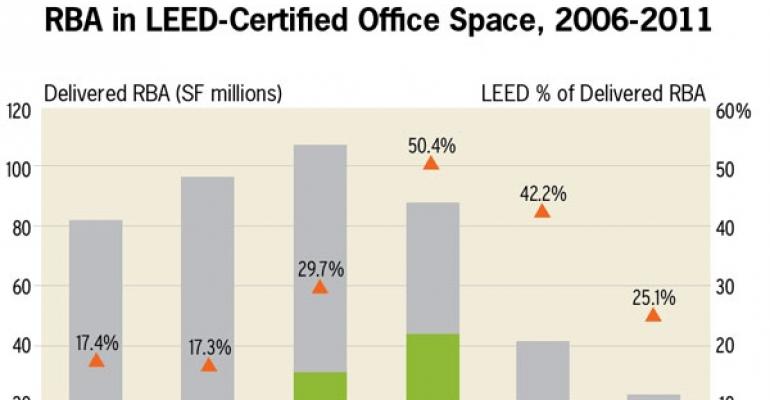One good measure of where the green building movement is going can be found in studying green office space, says Anthony Guma, LEED-AP, a research director for CoStar Group in Washington, D.C.
From 2006 to 2009, says Guma, for properties 50,000 sq. ft. and greater, the percentage of rentable building area (RBA) in LEED-certified office space grew strongly, thanks in part to developers in markets like Houston, Chicago, New York, Seattle and Washington, D.C.
In 2009, close to 50 percent of the total RBA delivered qualified as LEED-certified. Although total development has dropped off since then, the percentage of LEED deliveries remains higher than in years past, according to Guma’s research.
A look at the net absorption of LEED-certified properties against a peer group of 50,000-sq.-ft. buildings completed since 2002 gives another indicator of how the supply of green office space has performed. The total percentage of LEED-certified space in this group increased modestly since 2008, but LEED office space’s percentage of total absorption has been consistently higher than its share of the inventory. This suggests that these spaces are filling up faster than spaces in non-LEED-certified buildings.
In 2009, approximately 43 percent of absorption occurred in LEED-certified buildings, while those buildings made up just 22 percent of total inventory. The gap has closed slightly as green development has picked up, but LEED buildings are still experiencing higher absorption than their less peers.

Sticking with a competitive set of buildings greater than 50,000 sq. ft. built after 2002, CoStar/PPR took a look at the percentage of LEED office space against the percentage of LEED net absorption between 2009 and 2011. The vast majority of markets found LEED office buildings capturing an outsized share of absorption relative to their share of the inventory.
Portland, for instance, saw more than 90 percent LEED total net absorption for that time period, although the market holds less than 40 percent of LEED-certified space when looking at total office product. Likewise, Cincinnati showed 80 percent of total net absorption was in LEED properties, while just 25 percent of its office space is LEED-certified.
In most markets, tenants are clearly favoring LEED buildings over less green alternatives, Guma has found. In the few markets in which the LEED spaces haven’t received their fair share of absorption in recent years, there has been limited construction, so the small number of buildings in the sample has caused some outliers. In Boston, for example, most of the LEED-certified vacant space is in three buildings that seem to be holding out for higher rents. In San Francisco, expanding tech tenants are favoring creative space with open floor plans in older, converted properties in transitioning submarkets rather than shiny new LEED-certified office towers.
However, says Guma, even with these few exceptions, office investors and developers should take note: Based on recent absorption trends, buildings lacking LEED certification could see occupancies suffer if tenants decide to move on to greener spaces.

